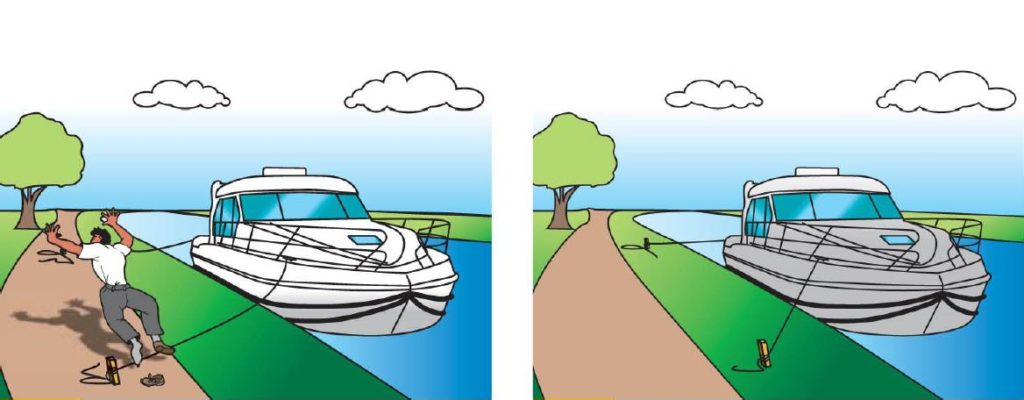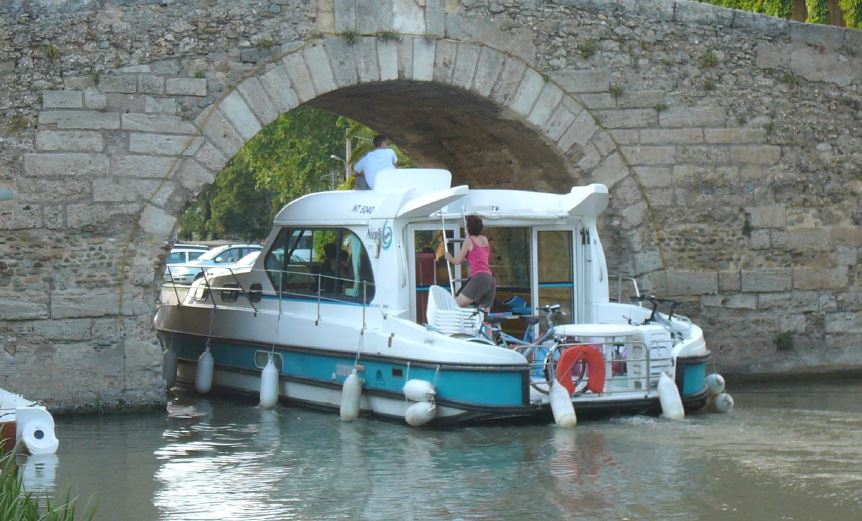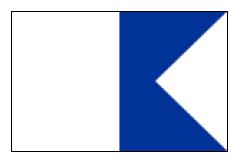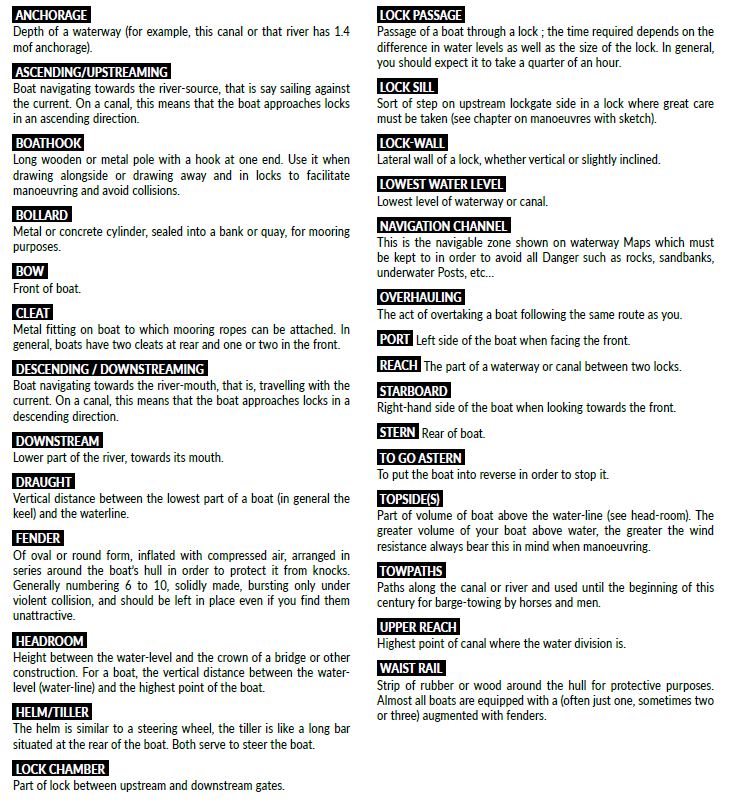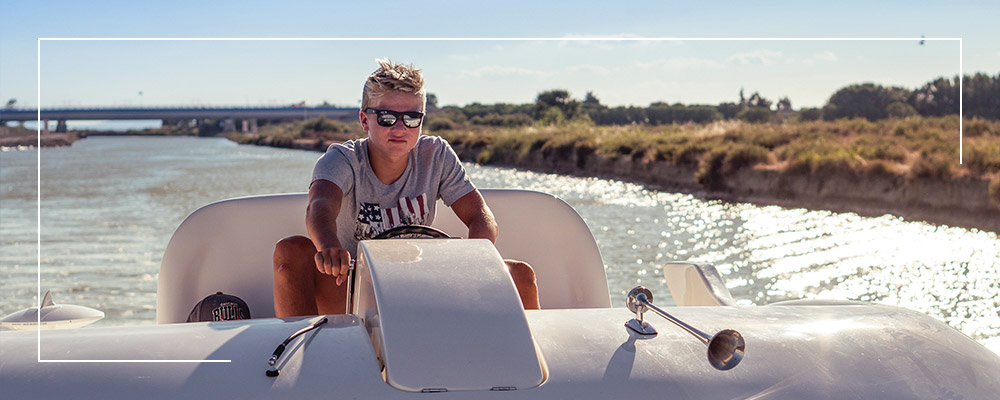
There’s nothing better than enjoying the slow pace of life as you gently cruise along the waterways. While watching the world go by remember these useful navigation tips…
- Maximum authorised speed
- on canals is 6 to 8 km/h
- on rivers is 10 km/h,
- in the marina 3 km/h.
- It is forbidden to navigate after sunset.
- When the only boat around you can navigate down the middle of the canal or river, but when you meet another boat, keep to the right but avoid any underwater roots which may stick out from the banks.
- Commercial boats always have priority over you. Do not try to overtake them (unless a crewman signals you to do so) especially at the approach to a lock. Please remember you are on holiday but they are at work.
-
You may moor wherever you like along the towpath unless a mooring sign forbids you.
- Please do not obstruct the right of way of pedestrians or cyclists on the towpath as they could injure themselves badly.
Do not tie mooring-ropes across the towpath
Also and do not obstruct the passage of other boats on tight bends, near locks or under bridges.
When coming alongside parallel to the quay or bank:
- Always manoeuvre at very low speed because the boat takes time to respond and reverse gear is your only brake.
- Always tie up the front end of the boat first: one crew member stands at the front of the boat with a boathook, making sure there is no underwater obstacle preventing your landing. Do not use your feet or legs to slow the boat down as this could lead to the severe risk of accident.
- Once the front of the boat has made contact with the bank, the crewmember gets down onto the bank with the mooring-rope, ties it, and ties the rear mooring-rope which you have thrown him.
- On a river, always tie up against the current. On a canal, tie up on the towpath side.
When coming stern (reverse) to the quay:
- Come in forward as close as possible to the place you wish to moor, turn around making sure you allow for wind or current and finish in reverse gear.
- Take care to ensure that the depth of water is sufficient at the quay and to avoid any hidden danger (tree stump, rock…) that could damage the hull or propeller.
How to turn around:
- Take up a position in the middle of the canal, checking that no other boat is coming either ahead or behind you.
- Turn the wheel fully to the right or left; pull forward and then reverse and so on until you have completely turned around.
- You can continue your cruise.
In case of wind:
- Moor on the windward (facing the wind) bank.
- At night, put your stern to the wind.
- Don’t tighten mooring ropes.
When you leave your mooring/berth:
- Detach your mooring-rope (don’t forget to collect your mooring pegs), move the stern of the boat into deep water to protect the propeller, then let go forward and off you go. Neatly roll up your mooring ropes to avoid anyone tripping over them and so they are ready for when you next need them.
-
On board your boat you will find several mooring ropes each about 25 metres in length. Coil them clockwise, ready to be used.
-
Make sure they are never caught up in the propeller and never let them trail behind the boat.
Never wind mooring ropes around your.
Never tie up a rope when passing through a lock (it could snap in half) and never try to tow another boat which has run aground.
-
All boats are equipped with an anchor for safety reasons. It is in no way a method of mooring and should only be used in an emergency.
-
On a river, in case of mis-manoeuvering near a dam or in case of engine failure, throw the anchor overboard, letting go the anchor line (chain + mooring rope + anchor). Never use the anchor on a canal.
ALWAYS BE AWARE OF THE HEIGHT OF YOUR BOAT WHEN GOING UNDER THE BRIDGES
- When driving the boat do not forget that the steering wheel is situated on the right of the boat and not in its middle so be aware of the full width of the boat.
- Be careful when you are on the roof.
- If however there are objects on the roof, remember to take them down before passing under the bridge.
The image below shows the main signs and signals that you will come across during your cruise. It is important that you have an understanding of them to maintain the safety of both your boat and your crew so please take some time to learn them.
You can also download a copy of the signs and signals using the button below.
- When travelling along a river you will frequently come across weirs next to locks. Don’t go near them. Instead when you are within 100m-200m of the lock ensure that you navigate nearer the riverbank that is closest to where the lock is located and therefore away from the weir.
- All boats are forbidden to moor, or to drop anchor, within 200m of a weir.
- In the event of a breakdown and your boat drifting towards the weir, use the anchor to stop the boat. Drop the anchor and rope having taken care to tie up the other end – noting that it is advisable that the rope length can be up to four times the river depth in the normal current or six times the river depth if it is very strong so if you need to stop quickly shorten the rope!
EXTRACT FROM GENERAL REGULATION
Your booking with Nicols includes the necessary ‘licence’ (Carte de Plaisance). This gives you and your crew permission to undertake travel on the waterways and be exempt from the requirements of the International Certificate for Inland Pleasure Craft Operators provided that:
- The crew has undergone the necessary training about driving the boat. Your base team will have done this with you before allowing you to depart.
- The boat is provided with the chartered boat certificate including its mechanical survey. A copy of this should be kept onboard.
- The charterer proves that he has taken out an insurance policy against any risks of damage to third party due to the boat or its crew, plus other required insurance policies. Copies of these should be kept on board.
- This licence is only valid for the dates and conditions mentioned on the licence.
Your crew are legally required to produce the above mentioned documents if asked to by any appropriate authority.
Failure to follow the above rules can lead to penalties as serious as fines or imprisonment.
Moving through an automatic lock on the tourism waterway.
